
* With so many MiG-21s lingering in service, there has been a good deal of interest in providing upgrades to the aircraft, equipping them with the latest avionics and weaponry. Along with production variants, the MiG-21 line also included a number of unusual experimental aircraft. In addition, the Soviets developed a set of prototypes of what looked like scaled-up MiG-21s or what might be called "Super MiGs", in the form of the "Ye-150" and "Ye-152", with the Chinese performing a similar exercise with their "J-8" series, which actually reached full production. This chapter provides a survey of MiG-21 upgrade programs, MiG-21 experimentals (loosely including the "Super MiGs" and J-8 series), and a summary of MiG-21 variants.
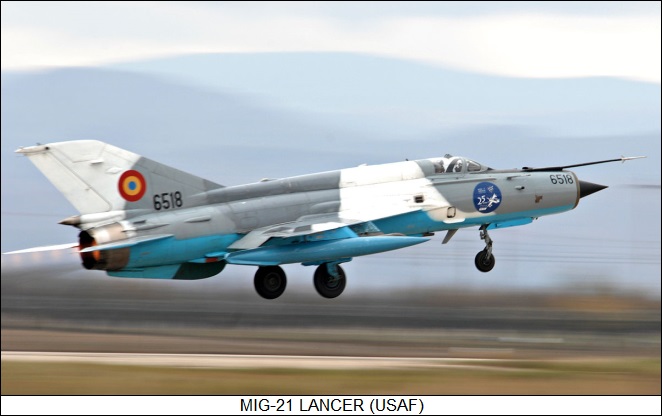
* By the 1990s, there were still thousands of MiG-21s in service, though the type was showing its age. Replacing so many aircraft with more modern machines was a very expensive prospect, and since the MiG-21's performance was still generally acceptable, unsurprisingly projects began to spring up to refit old MiG-21s with modern avionics and AAMs.
It was not entirely a new idea. After Egypt dumped the country's threadbare Soviet sponsor in favor of the more prosperous Americans in the wake of the October 1973 Mideast War, the Egyptians initiated a relatively modest "Westernization" update of their MiG-21 fleet, performed by British Aerospace and Rolls-Royce. The update was mostly an avionics fix, involving fit of a GEC-Marconi HUD, Teledyne navigation and IFF units, and Tracor AN/ALE-40 chaff-flare dispensers. Egyptian MiG-21s also learned to carry Western weapons, such as Sidewinder AAMs.
More earnest efforts to update the MiG-21 began after the fall of the Soviet Union, when Russian industry was trying to find ways to fend off starvation. An updated MiG-21bis was demonstrated at the Moscow Aeroshow in 1992, fitted with medium-range R-27 (NATO AA-10 Alamo) AAMs and short-range R-73 (NATO AA-11 Archer) AAMs. This seems to have been a dummy fit, presented just to show off the possibilities and offered along with a menu of avionics upgrades.
Even before that time, the Russians had been talking with India about updating the Indian Air Force (IAF) MiG-21bis fleet, leading to the signing of a preliminary industrial agreement to that end in 1993 and a final agreement in 1996, specifying upgrade of 125 MiG-21bis aircraft, with an option for upgrade of 50 more.
The original update configuration was simply known as "MiG-21-93", with a prototype upgrade aircraft flown in 1995. The details of the upgrade configuration evolved for a few years until they finally converged on a definitive specification, known as "MiG-21UPG". It featured:
The upgrade also featured a "service life extension program (SLEP)" to refurbish and "zero time" the airframe. Two IAF MiG-21bis fighters were upgraded in Gorkiy by the MiG organization to the MiG-21UPG configuration, which were delivered back to India in December 2000. HAL then converted the rest of the IAF MiG-21 fleet using Russian-supplied kits, with the first HAL upgrade publicly displayed in October 2001.
The MiG-21UPG update did not include a modification evaluated by the Kiev Military Aviation Institute in Ukraine, involving a new engine intake that looked like a vented ring installed around the old intake. According to the designers, this installation finally eliminated the MiG-21's long-standing tendency to suffer engine stalls when the aircraft's longitudinal axis veered off the line of flight. Nobody seemed to express much interest in the modification, however, possibly because after so many decades and experience with flying the MiG-21, the problem wasn't really a problem any more.
* The MiG organization offered MiG-21UPG upgrades to other MiG-21bis users, though the baseline MiG offering featured all-Russian avionics. There were conversations between the Russians and several foreign air forces about MiG-21UPG upgrades, but little came of it.
MiG-21 upgrades were performed by foreign firms. In 1993, Elbit Systems of Israel and Aerostar of Romania began a joint effort to update the 100 MiG-21MF fighters and 10 MiG-21UM trainers of the Romanian Air Force (RoAF) to the "Lancer" standard. The Lancer upgrade included:
A SLEP was performed on the airframes. Weapons carriage included the AA-11 Archer and Israeli Rafael Python 3 AAMs; as well as the Elbit Opher infrared-seeking guided bomb, the IAI Lizard laser-guided bomb (LGB), and various unguided bombs and rocket launchers. The Rafael Litening target designation pod could be carried for directing LGBs.
The prototype single-seat "Lancer I" performed its initial flight in 1995, with the prototype two-seat "Lancer II" following in 1996. Single-seat machines upgraded to a ground-attack configuration were designated "Lancer A" by the RoAF, while the two-seaters were known as "Lancer B", and the air-superiority machines as "Lancer C".
Aerostar then went on to perform an upgrade program for 12 Croatian MiG-21s, including 8 MiG-21bis single-seaters and 4 MiG-21UM two-seaters, with the deal signed in 2002. Although initial reports suggested that this was a Lancer-class upgrade, it was actually much more modest, involving refurbishment of the airframes -- which were purchased by Croatia as surplus from some unspecified Eastern European nation -- and a simple avionics upgrade, including a new beacon navigation receiver unit, a GPS receiver, plus NATO-compatible IFF and radios.
There were no upgrades to cockpit instrumentation. Incidentally, a decade later, Croatia put a set of MiG-21s through refurbishment in Ukraine, the refurbished aircraft including some of those that had been refurbished in the first cycle. In roughly the same timeframe as the initial Croatian update, Bulgaria conducted an even more modest upgrade of their MiG-21bis single-seaters, focusing on fit of a GPS receiver and new flight-data recorder; the upgrade may also have involved NATO-compatible IFF and radios. The intent was simply to keep the MiG-21s operational until a modern replacement was acquired.
There were other proposals for MiG-21 upgrades. IAI promoted a "MiG-21-2000" upgrade package, with such features as Elta EL/M-2032 multimode radar; a HUD and color MFDs; HOTAS controls; Elbit DASH sight; a GPS receiver, a mission computer; modern countermeasures system; one-piece windscreen; and potential carriage of Israeli munitions. A "prototype" MiG-21-2000 was flown in 1998, but there were no takers. Since that time, interest in upgrades has largely faded out -- though many advanced Chinese J-7 / F-7 variants remain in service and could receive upgrades.
BACK_TO_TOP* There were quite a few branches off the main line of MiG-21 development, some of which -- the Ye-50 and the Ye-66 demonstrators -- have already been mentioned. There were a number of trials fits -- one MiG-21 was even fitted with wheel/ski landing gear, for operation off of snow-covered airstrips -- and some major redesigns.
In 1961, a state requirement was issued for an all-weather interceptor based on the MiG-21. It was to be fitted with the then-new RP-22 Sapfir-21 radar and a more powerful engine, the Tumanskiy R-21F. Trying to fit the radar into an inlet that provided adequate airflow proved tricky, and so Mikoyan engineers decided to try an inlet to under the fuselage, as in the modern US F-16 fighter. Tweaking the design also led to the introduction of canard fins alongside the nose.
The construction of two prototypes designated "Ye-8" was authorized, with the initial flight of the first prototype on 17 April 1962, with Georgiy Mosolov at the controls. Initial trials were plagued by engine problems, culminating with the disintegration of the engine compressor on 11 September 1962. Mosolov suffered a rough ejection and wasn't recovered for over two hours, but emergency medical procedures managed to save his life.
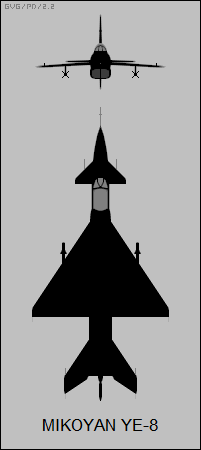
By that time, the second Ye-8 was flying, the test pilot being Aleksandr V. Fedotov, who took it into the air for the first time on 29 June 1962. However, the loss of the first prototype effectively killed the program. Aerodynamically, OKB engineers felt they had an outstanding design, but there was little confidence in the engine development program. Had the Ye-8 gone into production, it would have been designated "MiG-23" -- but once again, this designation was set aside, to be resurrected for a later aircraft.
* The next exercise in dramatically rethinking the MiG-21 was the "I-23-31", sometimes referred to incorrectly in Western sources as the "MiG-21PD". In the early 1960s, the Soviets were very interested in development of short take-off & landing (STOL) aircraft, and the Mikoyan OKB came up with a series of different designs based on the MiG-21 to achieve STOL capability.
One option was to install "liftjets" in the fuselage. These were stubby turbojets mounted near-vertically in an aircraft to provide high STOL thrust for a short period of time. To get experience, Mikoyan OKB engineers built the I-23-31, which was basically a stock MiG-21PFM with twin Kolesov RD-36-35 liftjets spliced in tandem into the fuselage at a fixed angle of 80 degrees backwards from the horizontal axis of the aircraft. Each liftjet could provide 23.0 kN (2,350 kgp / 5,180 lbf) thrust, with the two engines covered by a louvered door that was hydraulically jacked up for take-offs and landings, and featuring a set of pivoting thrust deflectors that permitted thrust vectoring over an angle of 50 degrees, with some forward travel to permit air braking.
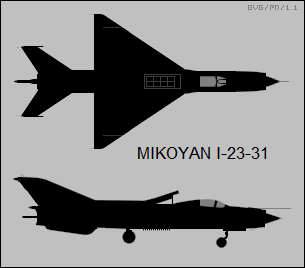
Initial flight of this lashup was on 16 June 1966, with Piotr Ostapenko at the controls. The aircraft suffered from very bad low-speed handling, with Ostapenko stating that he had to land with afterburner engaged! After about a year of trials, flights were discontinued, probably with some general relief that the damn thing hadn't killed anyone to that time. Even good-natured prototypes have their unknown idiosyncrasies and are built with unproven technology, making them potentially dangerous, and flying one that was clearly a beast was just asking for trouble. Mikoyan engineers were also interested in using variable geometry or "swing wings" to obtain STOL performance, and that line of investigation led to the MiG-23 family -- the MiG-23 that actually was built.
* Arguably the most drastic variation on the MiG-21 was the "MiG-21I", where the "I" stood for "Imitator", with the type also informally known as the "Analog". Two were built in the later 1960s, strictly as research machines to test out wing configurations for the Tupolev Tu-144 supersonic transport (SST). They were production MiG-21S aircraft refitted with a long-chord double-delta wing.
The whole thing turned out to be mostly an exercise in futility, since Mikoyan engineers needed to get the proper specifications for the wing from the Tupolev engineers, while the Tupolev engineers couldn't give them specifications without data from Analog flights. According to the story, in 1968 Artyom Mikoyan lived in the same state apartment block as Andrei N. Tupolev, at 80 years old still working and revered as the "grand old man" of Soviet aircraft design. When the two men met in the elevator, Tupolev would politely ask Mikoyan: "When do I get my Analog, Artyom Ivanovich?"
The first Analog didn't perform its first flight until 18 April 1968, with test pilot Oleg V. Gudkov at the controls. By that time, the Tu-144 prototype was close to completion. The second Analog didn't fly until late 1969. The prototypes were used to evaluate variations in wing configurations, and were also used by Tu-144 test pilots to acquire experience in flying a machine with the double-delta configuration.
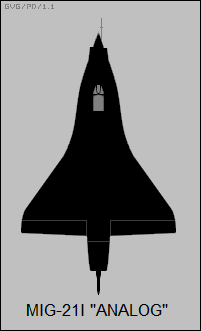
Handling was surprisingly good for an aircraft that was intended solely as an aerodynamic demonstrator for a big commercial transport, though it had some quirks that could trap the unwary. In fact, some of the test pilots found it so agile, with its low wing loading, that they lobbied for its production as a fighter. The first Analog was lost in a crash on 28 July 1970, when the test pilot, Viktor Konstantinov, got overly enthusiastic in some freelance low-level aerobatic maneuvers and lost control, Konstantinov being killed when the machine fell to earth. The second Analog remained in test and trials service for several more years, to be finally retired to the Monino air museum near Moscow.
BACK_TO_TOP* During the early years of the MiG-21's history, the Mikoyan OKB worked on a series of designs for big, high-performance interceptors that looked like nothing more than scaled-up MiG-21s. In reality, the "Ye-150" and successor "Ye-152" designs owed little in specific to the MiG-21; as mentioned, the "balalaika" design was established by TsAGI studies, and was an entirely obvious idea. The Sukhoi OKB used exactly the same configuration for its Su-9 interceptor, which as a result looked very much like the MiG-21.
As mentioned, the MiG-21 interceptor line was intended for defense of built-up regions in the western USSR, the type clearly lacking the range needed for defense of vast empty regions of the Soviet East. Long-range interceptors were needed to provide a more thorough net to catch intruders trying to sneak in the "back door".
The threats were becoming more formidable as well. Since 1956, the US had been occasionally flying Lockheed U-2 spyplanes over the USSR, operating at altitudes well above those that could be reached by any Soviet fighter. Work on rocket-boosted fighters had been performed with an eye towards shooting down the U-2s -- though it proved an ineffective solution, since the fighters were uncontrollable once they reached such high altitudes. To make matters worse, the US was introducing the Mach 2 General Dynamics B-58 Hustler into service, and looking down the road to the introduction of a Mach 3 strategic bomber, which would materialize as the North American B-70 -- though in fact, the B-70 would never get beyond the prototype stage.
What all that meant was that the USSR needed an interceptor with long range, high ceiling, and high speed. In the late 1950s, the Mikoyan OKB began development of a demonstrator for such an interceptor, with the "Ye-150" rolled out in December 1958. It performed its first flight on 8 August 1960, with Aleksandr Fedotov at the controls. By that time, the U-2 was no longer an active annoyance, one having been shot down by SAMs on 1 May 1960, leading the US to cease air overflights of the Soviet Union. However, American bombers remained a threat.
The Ye-150 looked very much like an oversized MiG-21, featuring the balalaika configuration, and even the same general landing gear arrangement -- all single wheels, nose gear retracting forward, main gear hinging in the wings into the fuselage. There was a big, hydraulically-operated one-piece airbrake behind the nosewheel. The wing had a leading-edge sweep of 60 degrees.
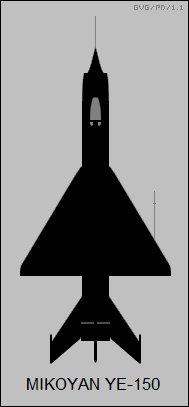
The Ye-150 had a large tapered intake cone to fit Uragan-5B (Hurricane-5B) interceptor radar, and was to be armed with a single semi-active radar-guided AAM under each wing. The tapered radome ended in a long pitot tube, which led to the machine being nicknamed "Yedinorog (Unicorn)". The machine was much bigger than a MiG-21, with an empty weight of 8,726 kilograms (19,237 pounds), 1.8 times that of the MiG-21F-13, and a length of 18.14 meters, 1.35 times as long as the MiG-21F-13.
The Ye-150 was powered by a Tumanskiy R-15-300 turbojet, with a dry thrust of 66.7 kN (6,800 kgp / 14,991 lbf), and an afterburning thrust of 99.5 kN (10,150 kgp / 22,376 lbf). The fuselage was almost a straight tube, with a prominent ring of afterburner cooling inlets around the rear, giving the aircraft something of the appearance of a "flying stovepipe".
Trials of the Ye-150 continued into 1962, with the aircraft providing extremely impressive performance, attaining Mach 2.65 (2,890 KPH / 1,795 MPH) at 19,100 meters (62,665 feet) and featuring a blazing rate of climb. The problem was that the R-15-300 engine was very unreliable; that was to be expected with such a powerful new engine, but the bugs proved very difficult to work out -- which is why it took the better part of two years to go from rollout to first flight.
* Despite the engine problems, the Ye-150 seemed extremely promising and the concept was felt worth further investigation. As a follow-up, the OKB engineers built two "Ye-152" prototypes with the R-15-300 engine, plus a single "Ye-152A" prototype with twin R-11F-300 engines, proven on the MiG-21.
The Ye-152 had a modified wing compared to the Ye-150, with the wing featuring a shallower sweep of 53 degrees and squared-off wingtips mounting a launch rail for a K-9 semi-active radar-guided AAM. The K-9 was a big weapon with cruciform fins at the tail and midbody, guided by Uragan-5B radar in the Ye-152's inlet cone, which had a simple conical shape. The modified wing increased the wing area by a factor of 1.16. A single ventral fin was added and the tailfin height was increased.
The Ye-152A had a similar forward fuselage, but the wings retained the 60 degree sweep of the Ye-150 and in fact were smaller than the Ye-150's, with the wing area reduced by a factor of 0.92. A K-9 AAM was carried on a pylon under each wing. The tailfin height was raised still further and twin canted ventral fins were fitted under the tail.
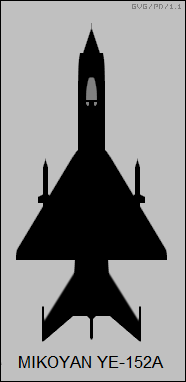
The Ye-152A was completed first, with Georgiy Mosolov performing the first flight on 23 November 1960. It was an impressive machine, capable of 2,500 KPH (1,552 MPH) at 20,000 meters (65,600 feet). It performed a flypast at the 1961 Tushino air show, with over-imaginative Western observers believing that it was -- of course -- the "MiG-23". It was assigned the NATO reporting name of "Flipper". The Ye-152A remained in service as weapons system testbed until 1965, when it was lost in a crash that killed the pilot, A. Kravtsov.
The first Ye-152 prototype performed its initial flight on 21 April 1961, once again with Mosolov at the controls. The performance was downright blazing, with the aircraft capable of 2,650 KPH (1,646 MPH) at 16,200 meters (53,150 feet) -- even when carrying two big dummy K-9 AAMs. Flying clean, it could reach 22,680 meters (74,409 feet). The aircraft, camouflaged as the "Ye-166" for the record books, set a number of world speed records, including a flight at an average of 2,681 KPH (1,665.2 MPH) over a 15/25-kilometer (9.3/15.5-mile) course on 7 July 1962, with Mosolov at the controls.
The second Ye-152 prototype performed its initial flight on 21 September 1961. While the first prototype was fitted with Uragan-5B radar, the second featured an improved radar, the RP-5 Smerch (Tornado) system. This required another change in radome configuration. Unfortunately, the R-15-300 engine continued to be troublesome and balky. Further work produced a supposedly "improved" R-15B-300 engine, which was installed in the second prototype. This machine was also brought up to something more like a production specification, with a "fat" spine like a late model MiG-21 for more fuel, plus a small streamlined "racing" canopy. The afterburner cooling vents around the tail were eliminated, having been found to be unnecessary.
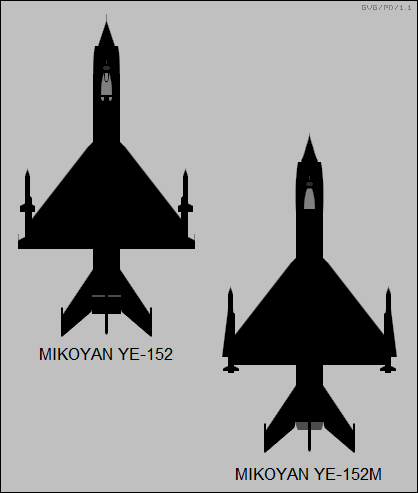
The K-9 AAM was abandoned -- it's hard to resist the thought that it turned out to be a "dog" -- in favor of the Bisnovat K-80 (NATO AA-5 Ash) AAM, with triangular cruciform wings and rectangular cruciform tailfins. The AAMs were once again mounted on the wingtips. There was work on fitting canard foreplanes, as evaluated on the Ye-6T demonstrators mentioned earlier, but the Ye-6T experiment didn't work out and the canard fit was abandoned, though the mounting fairings alongside the nose for the canards were retained. The modified Ye-152 was originally redesignated the "Ye-152P" -- with "P" for "perekvatchik (interceptor)" -- but was finally designated simply "Ye-152M", with "M" of course standing for "modifitseerovanniy (modified)".
___________________________________________________________________
MIKOYAN YE-152M:
___________________________________________________________________
wingspan:
8.793 meters (28 feet 10 inches)
wing area:
42.89 sq_meters (461.1 sq_feet)
length:
19.66 meters (64 feet 6 inches)
empty weight:
11,440 kilograms (25,225 pounds)
normal weight:
18,469 kilograms (40,725 pounds)
max speed at altitude:
2,680 KPH (1,665 MPH / 1,450 KT)
service ceiling:
22,670 meters (74,350 feet)
combat radius:
1,470 kilometers (913 MI / 795 NMI)
___________________________________________________________________
Unfortunately, the engine problems persisted, and that meant the Ye-152M was the end of the road for that particular line of investigation. The Sukhoi OKB had been working in parallel on a similar machine, the "T-37", with the balalaika configuration and the R-15-300-series engine, and that program ended up being axed before completion of a prototype.
The Ye-152M remained in trials until 1967, when it was put on display at the Domodedovo Air Show for all to inspect. It was labeled the "Ye-166", despite the fact that the first Ye-152 prototype had been used to set the speed records. The Ye-152M was then retired to the air museum at Monino, where it remains today. What happened to the original Ye-150 and the first Ye-152 prototype remains unclear; apparently they were scrapped.
The Ye-150/152 was a dead end in itself, but it gave the Soviet aerospace industry valid experience in design of high-speed aircraft and improved interceptors. The AA-5 Ash AAMs and Smerch radar would be used on the big Tupolev Tu-128 "Fiddler" long-range interceptor, and the Smerch and the R-15B-300 engine would be used on the Mikoyan MiG-25 "Foxbat" interceptor. The engine would prove workable enough on the MiG-25, though its time between overhauls would always be painfully short.
BACK_TO_TOP* The Chinese developed their own "Super MiG", very much along the lines of the Ye-152A. Work on an advanced long-range interceptor began at the Shenyang factory in the mid-1960s, with the initial flight of the first "J-8" prototype on 5 July 1969. The J-8 was of the same general form as the Ye-152A, with a balalaika configuration, twin canted ventral fins, tricycle landing gear in the same arrangement, a large single-piece airbrake behind the nosewheel, and powered by twin WP-7A turbojets. In fact, the resemblance was so close that it seems plausible that the Chinese had got wind of plans for the Ye-152A before communications with the USSR went south.
The development program did not go smoothly, the J-8 being fitted with J-7I radar and PL-2 AAMs for lack of anything better. The PLAAF didn't get a machine for evaluation until 1980, with the type entering service in very limited numbers in 1981.
The J-8 amounted to a development type, with work begun in 1976 on an improved variant that would emerge as the "J-8I". It featured a much better radar; a twin-barreled 23-millimeter cannon, replacing the two separate 23-millimeter cannon of the original J-8; a centerline pylon for an external tank plus four underwing pylons for AAMs; and a Type II ejection seat with back-hinged canopy, instead of the treacherous forward-hinged canopy and ejection system of the J-8. A prototype was rolled out in 1980, only to be destroyed in a ground fire; the second prototype performed its initial flight on 24 April 1981.
___________________________________________________________________
SHENYANG (SAC) J-8I:
___________________________________________________________________
wingspan:
9.34 meters (30 feet 8 inches)
wing area:
42.2 sq_meters (454.25 sq_feet)
length with probe:
20.5 meters (67 feet 3 inches)
height:
5.06 meters (16 feet 6 inches)
MTO weight:
12,700 kilograms (28,000 pounds)
max speed at altitude:
2,230 KPH (1,385 MPH / 1,205 KT)
service ceiling:
20,500 meters (67,240 feet)
range:
1,245 kilometers (775 MI / 675 NMI)
___________________________________________________________________
The J-8I entered PLAAF service in small numbers, with production believed to have ended in 1989. In the late 1990s, survivors were updated with improved avionics, particularly countermeasures, to "J-8E" standard, and some J-8Is were converted to "J-8Z" reconnaissance machines, carrying various types of centerline reconnaissance pods.
* The J-8 and J-8I appear to have amounted to learning experiences for the Chinese aircraft industry, providing lessons which led to a more satisfactory interceptor aircraft, the "J-8II". Work on the J-8II began at the Shenyang factory in 1983, with the first prototype performing its initial flight on 12 June 1984, leading to production of a small batch of a few dozen development aircraft.
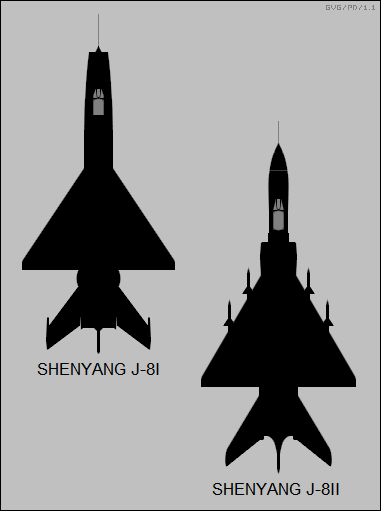
The J-8II was a substantial rethinking of the design, fitted with a solid nose for long-range radar; dee-type engine intakes, like those of the US McDonnell F-4 Phantom or Soviet MiG-23; three stores pylons under each wing; a single folding ventral fin; and WP-13AII turbojets. The result was an aircraft that had some resemblances to the Soviet Sukhoi Su-15 "Flagon" interceptor, as well as the Phantom. AAM armament was usually the PL-10 AAM, a Chinese-produced version of the Italian Aspide AAM, itself a derivative of the US Sparrow AAM. Pictures have also shown the J-8II carrying bombs and other offensive stores -- but given its optimizations as an interceptor, strike was clearly a secondary role.
___________________________________________________________________
SHENYANG (SAC) J-8II:
___________________________________________________________________
wingspan:
9.34 meters (30 feet 8 inches)
wing area:
42.2 sq_meters (454.25 sq_feet)
length:
21.6 meters (75 feet 10 inches)
height:
5.41 meters (17 feet 9 inches)
empty weight:
9,240 kilograms (20,375 pounds)
normal weight:
14,300 kilograms (31,530 pounds)
MTO weight:
17,800 kilograms (29,250 pounds)
max speed at altitude:
2,335 KPH (1,450 MPH / 1,260 KT)
service ceiling:
20,200 meters (67,255 feet)
combat radius:
800 kilometers (500 MI / 430 NMI)
___________________________________________________________________
Aerodynamically, the J-8II appears to have been a sound aircraft, but Chinese industry found it difficult to develop radar and other avionics adequate to allow the aircraft to live up to its potential. The Chinese worked with Grumman to fit the machine with US Westinghouse AN/APG-66 radar and other US avionics, but the plan fell through after the Tianemen Square massacre in 1989.
The Chinese went ahead with production of the type as the "J-8B", with their own radar and avionics, flying the first example in late 1989. A similar "J-8D" was first flown in 1990, the major distinction of this variant being fit of an inflight refueling probe. A total of about 300 J-8B/D machines was obtained by the PLAAF. The type was assigned the NATO reporting name of "Finback".
However, the avionics and armament of production aircraft remained unsatisfactory, leading to introduction of the "J-8H", with updated avionics; wing fences to improve handling; modernized WP-13B engines; and the inflight refueling probe as standard. First flight of the J-8H took place in 1998. J-8Bs and J-8Ds were upgraded to comparable "J-8BH" and "J-8DH" standard. The J-8H was followed by the "J-8F" with further improved avionics, possibly including advanced Russian radar; there may have also been upgrades to this spec. The final variants were the "J-8G" defense suppression and the "JZ-8F" tactical reconnaissance variants. An "F-8IIM" for the export market, with Russian radar and AAMs, was promoted in the late 1990s, but there were no takers. It is not clear if any J-8s remain in service; it was a dead end.
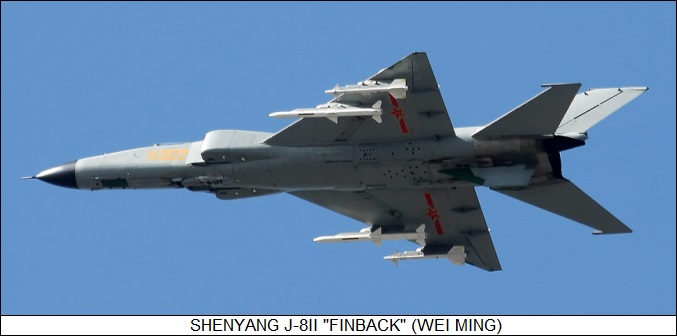
* The J-8 family doesn't appear to have been involved in any combat, but a J-8II did figure in an international crisis between the US and China. On 1 April 2001, a US Navy EP-3E II aircraft -- essentially a Lockheed P-3 Orion sub-hunter, fitted out with signals intelligence (SIGINT) gear -- was performing an intelligence mission, observing Chinese "emitters" from international airspace over the ocean.
As is not unusual during such missions, it was intercepted and "ghosted" by two Chinese fighters, in this case both J-8II Finbacks. Such encounters often involve the fighters coming very close to the SIGINT aircraft -- apparently as a form of harassment, but also to obtain pictures of the "antenna farm" of the aircraft's SIGINT gear, to obtain clues to what kind of gear is in use. However, flying very close to a large aircraft can be dangerous due to its wake turbulence, and in this case there was a collision between the Finback and the Aries. The Finback crashed, its pilot being lost, and the Aries was badly damaged, the crew being forced to land on China's Hainan Island after trashing their secret SIGINT gear.
The crew and the aircraft were interned. A tedious diplomatic quarrel followed, with the crew and the aircraft finally being returned. The crew reported that they were treated well. The Aries was broken down and returned in segments in a Russian Antonov An-124 heavylift cargo transport.
BACK_TO_TOP* Due to limitations on time, I had spent much of 2006 turning out relatively short write-ups of second-tier aircraft, and when I finally had a month free of too many interruptions, I decided to build a more satisfying write-up, on the MiG-21. It was a lot of work to finish in one month, particularly when I found out that the Chinese J-7 series was elaborate enough to almost deserve a stand-alone article. I suppose adding the "Super MiGs" was asking for trouble, but I figured that if they didn't fit here, they didn't fit anywhere else -- and if I didn't include them, I would end up feeling compelled to add them sooner or later anyway.
I was greatly aided by availability of detailed, clear sources, which is more than I normally expect for Soviet types. However, I must warn that the list of users is likely to be error-prone -- nailing down exactly what users obtained what variants and what happened to them is trying to track a fuzzy and moving target.
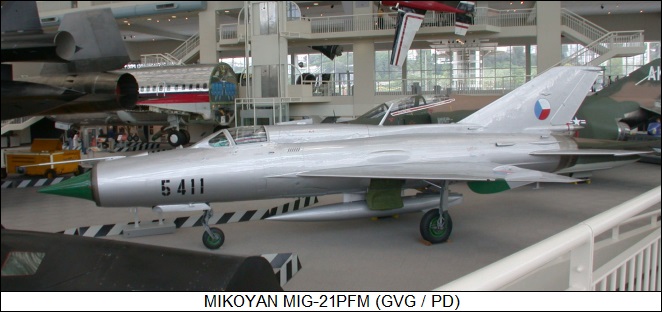
* Sources include:
Some materials on Chinese MiG-21 variants and the J-8 series were obtained from the China Defense website.
* Revision history:
v1.0.0 / 01 aug 06 v1.0.1 / 01 aug 08 / Review & polish. v1.0.2 / 01 jan 09 / Hasty update as part of site graphics upgrade. v1.0.3 / 01 may 10 / Review & polish. v1.0.4 / 01 may 12 / Added JL-9. v1.1.0 / 01 apr 14 / Simplified user list, added JC-17 details. v1.1.1 / 01 mar 16 / Review & polish. v1.1.2 / 01 feb 18 / Review & polish. v1.1.3 / 01 jan 20 / Review & polish. v1.1.4 / 01 nov 21 / Review & polish. v1.1.5 / 01 oct 23 / Review & polish.BACK_TO_TOP
